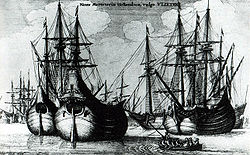Fluyt: Difference between revisions
No edit summary |
|||
| Line 11: | Line 11: | ||
Fluyts appear in [[Ensemble Studios|Ensemble Studio's]] ''[[Age of Empires III]]'' as versatile ships that are exclusive to the [[Netherlands|Dutch]] civilization. |
Fluyts appear in [[Ensemble Studios|Ensemble Studio's]] ''[[Age of Empires III]]'' as versatile ships that are exclusive to the [[Netherlands|Dutch]] civilization. |
||
In many PC games involving ship combat |
In many PC games involving ship combat — such as [[Pirates of the Burning Sea]], [[Sid Meier's Pirates]], Port Royale, Tortuga and High Sea Traders — in 17th and 18th century settings a fluyte is included (usually called by the English term "flute," rather than the Dutch spelling ''fluyt''). |
||
==References== |
==References== |
||
Revision as of 11:30, 18 December 2008

A fluyt, fluit, or flute (IPA: [flœt:]) is a Dutch type of sailing vessel originally designed as a dedicated cargo vessel. Originating from the Netherlands in the 16th century, the vessel was designed to facilitate transoceanic delivery with the maximum of space and crew efficiency. The inexpensive ship — which could be built in large numbers[1] — usually carried 12 to 15 cannon, but was still a somewhat easy target for pirates. Nonetheless, the fluyt was a significant factor in the 17th century rise of the Dutch seaborne empire.[2]
Ship design
The standard fluyt design minimized or completely eliminated its armaments to maximize available cargo space, and used block and tackle extensively to facilitate ship operations. This ship class was credited in enhancing Dutch competitiveness in international trade, and was widely employed by the Dutch East India Company in the 17th and 18th centuries.[3] However, its usefulness caused the fluyt to gain such popularity that similar designs were soon developed by seagoing competitors of the Dutch.
The design of fluyts was largely similar to that of the early galleons. These ships typically weighed 200-300 tons and were approximately 80 feet in length. The pear-shaped vessel had a large cargo bay near the waterline and a relatively narrow deck above. In part, this design was a method used to avoid high taxes collected by Denmark in the Oresund, which was assessed based on area of the main deck. The fluyt was square rigged with two or three masts. Masts were much higher than those of galleons to allow for greater speed. At times fluyts were also armed and served as auxiliary vessels, which was a common practice in the Baltic Sea.
Appearances in modern media
Fluyts appear in Ensemble Studio's Age of Empires III as versatile ships that are exclusive to the Dutch civilization.
In many PC games involving ship combat — such as Pirates of the Burning Sea, Sid Meier's Pirates, Port Royale, Tortuga and High Sea Traders — in 17th and 18th century settings a fluyte is included (usually called by the English term "flute," rather than the Dutch spelling fluyt).
References
Images
-
front view
-
side view
| Model of the late 17th Century fluyt Derfflinger |
|---|


